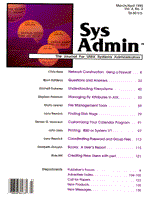
Sidebar: How Do Other Operating Systems Treat the Filesystem?
Often considered one of the most rudimentary of all operating systems, MS-DOS in many places bears a striking resemblance to UNIX. The simple structure of the MS-DOS filesystem resembles that of S5. Following the boot block, there is a File Allocation Table (FAT), which serves the same purpose as the inode list. The remainder of the partition consists of data blocks. The size of the data blocks is configurable, but by default is based upon the size of the drive. [Editor's Note: The maximum number of entries the FAT can hold is 65,536. Using 2,048-byte blocks, MS-DOS can represent drives as large as 128 megabytes. 4,096-byte blocks represent up to 256 megabyte partitions, and 8192-byte blocks go up to 512 megabyte partitions. Of course, smaller partitions may need no more than 1,024-byte blocks and floppy drives or RAM-drives may use 512-byte blocks, making such a block size identical to the sector size. -- Larry Reznick] OS/2, on the other hand, has two different filesystems that it can use. First, it can adopt the FAT structure of MS-DOS, but it does this primarily for compatibility reasons. Second, it can use the High Performance File System (HPFS). In HPFS, the inodes are called fnodes, and the list is maintained in the center of the disk instead of at the beginning. The remainder of the disk is configured as data blocks, but the blocks are written from the center of the disk out. Whenever a file is requested, the drive head goes immediately to the center, reads the fnode information, then moves slightly in either direction to where the data is stored. This minimizes the seek time, and because the hard drive is the slowest component of any computer, the access time is significantly reduced.
|